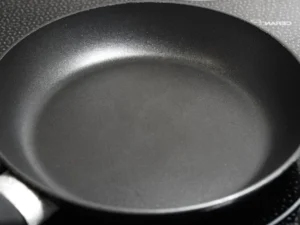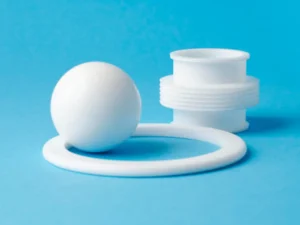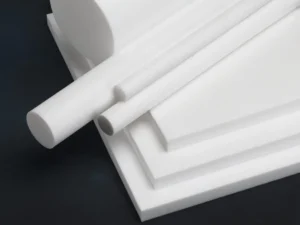From cookware to aerospace engineering, the applications and classification of Teflon have no bounds. It is well known for its strength, excellent temperature resistance, and non-sticky nature. However, this material is more complex than it may sound.
The Teflon coatings are also very useful in protecting the material from stickiness. Different types of Teflon serve differently to human beings. This guide will explore their classification and give you detailed insight. So, let’s jump in!
Overview of Teflon & History
Teflon is a solid white material composed of many tetrafluoroethylene monomers. It consists of carbon and chlorine atoms; however, chlorine atoms are packed around the carbons in a chain. Its usage is common, and almost every industry uses it in one way or another.
The most common example is that it is used in the utensils and pans that we use in our homes. It was founded back in 1960 by Roy J. Plunket. Due to its non-sticky nature, it was used in World War II as an anti-rust agent.
As I said, Teflon is not a simple material; it has different types and behaviors. These types serve different industries depending on their properties. Those properties include its resistance against rust, moisture, acid, bases, oils, and hydrocarbons.
Types of Teflon
As you know, Teflon has different variants that share different physical properties. Its usability is highly dependent on the properties that its various kinds equip. Here are the basic types:
- Polytetrafluoroethylene
- Fluorinated ethylene propylene
- Perfluoroalkoxy
- Ethylene tetrafluoroethylene
These types differ based on heat resistance, forming process, and mechanical properties. There may be other differences. However, these three attributes make them suitable for different industries and uses. The details about their properties are as follows:
-
Polytetrafluoroethylene (PTFE):
This is the most robust type of Teflon. It can handle the extreme temperature of 260°C to 300°C. Due to its intense heat resistance, it is applied as a coating on the surface of utensils. Moreover, it has a low friction coefficient, making it suitable for use as a lubricant.
-
Fluorinated ethylene propylene (FEP):
It has a lower temperature-bearing capacity (200°C) than PTFE Teflon. Due to its low melting point, it is used in the fabrication process. Above all, it is highly resistant to weathering, UV radiation, and atmospheric pollutants.
-
Perfluoroalkoxy (PFA):
It is one of the strongest and stiffest types of Teflon. As far as the application is concerned, this type is used in semiconductor manufacturing. It can bear the extreme temperature of 260°C, just like PTFE. It is very flexible and is usually used in those products where flexibility is a priority.
-
Ethylene tetrafluoroethylene (ETFE):
It is not very heat resistant as compared to the precious types. However, it offers strong corrosion resistance. Due to its ability to fight against rust, industries use it in architectural membranes and aerospace interiors. It is also lightweight compared to all other types of Teflon discussed above.
Point to Remember: Teflon can be divided based on its presence, forms, and applications. However, the above-given types of the most basic and other types arise from these. For example, Tefzel teflon is a type that is based on ETFE.
Teflon Coating Types
As I mentioned earlier, Teflon is used to coat different utensils, pans, cookware, and other products. However, there are different types of Teflon coatings, each varying in how they adhere to the substrate.
It is interesting to note that teflon coatings are the most common form of teflon. These coatings are suitable for surfaces such as steel, aluminum, glass, and plastic. Teflon is used in cookware to stop food from sticking on the surface of pans. Here are some different types of Teflon coating that are commonly used:
| Teflon Coating Type | Features and Description |
| PTFE Coating | Non-stick surface, High-Temperature resistance (up to 500°F), Chemically Stable, Maximum operating temperature of 290-300°C, Low friction coefficient |
| FEP Coating | The nonporous film is resistant to Chemicals, Melts, and Flows during baking. Maximum use temperature is 200 ℃. |
| PFA Coating | High-Temperature resistance (up to 500°F), Tough and Durable, Non-stick coating, Stronger, more rigid, and Stiffer |
| ETFE Coating | Tough and Durable, Excellent Chemical Resistance, Available in Powder Form, Can be used at 150°C. |
| Tefzel Coating | Exceptionally Tough, Not Fully Fluorinated, Available in Powder Form, Based on Solvents. |
| Teflon Dry Lubricant Coating | Uses PTFE as main ingredient, Solvent-based, Ideal for High Pressure and Velocity Situations, Provides Lubrication for moving parts such as hinges, chains, gears |
Applications of Teflon
Teflon is a beneficial compound in many ways. All of its types are 100% safe and being used worldwide. In the section below, we will explore some typical applications of Teflon.
- Cookwares: Teflon is non-sticky, so it is used on the cookware’s surface to prevent the stickiness produced by the food during heating. Utensils become very easy to clean due to no stickiness.
- Textile Industry: Premium brands of clothing apply a thin coating of Teflon on the cloth to make it strain-resistant. With the Teflon layer, the strains do not leave their signs and become accessible to clean.
- Automotive Industry: Some types of Teflon, such as PTFE, have low coefficients. They are used as lubricants in cars to increase the life of moving parts like gears and engines.
- Aerospace Industry: The aerospace industry values Teflon. Thanks to its resistance to corrosion and extreme environments. So, aerospace engineers use it for making seals, gaskets, O-rings, and bearings. Fluorinated ethylene propylene (FEP) is common in this industry.
- Food cans: When food needs to be preserved, the company owners apply a thin layer of Teflon on the interior side of the cans. This coating prevents the food from sticking to the can.
- Chemical Labs: The Teflon is used on the components that are used in chemical laboratories. The reason is that it is an inert material and does not react with any other material. Therefore, flasks with different chemicals remain safe due to the inertness of the Teflon.
Characteristics & Properties of Teflon
The usability of Teflon has no bounds. Thanks to its user-friendly characteristics, it is one of the most used materials in many industries. In the section below, some of the most important characteristics are as follows:
- Non-stickiness: Teflon does not react or make bonds with any other element. Even very thin films also show good non-stick properties.
- Heat resistance: Teflon has excellent heat resistance and low-temperature resistance. Its coatings can withstand high temperatures to 300°C continuously. It indicates that Teflon has excellent thermal stability. On the other hand, it can also work at freezing temperatures without embrittlement.
- Acid & Base Resistance: Teflon offers excellent resistance to acid and base. The pans that have a coating of Teflon do not deteriorate when they come in contact with acids. Moreover, it is inert, so it does not react with acid or with any chemical.
- Sliding property: Teflon has a low friction coefficient. The friction coefficient changes when the load slides, but the value is only between 0.05-0.15.
- Absorb vibrations: One of the most prevalent reasons Teflon is used in machinery is its absorption of vibrations and sound. The heavy-duty machines usually vibrate during their operations. However, using Teflon coating reduces their vibration and increases their lifespan.
- Moisture resistance: The surface of the Teflon coating film does not stick to water and oil. It minimizes solution adhesion during production operations. If there is a small amount of dirt, wipe it off.
- Wear resistance: It shows excellent wear resistance under high loads. Under a particular load, it has the dual advantages of wear resistance and non-sticking.
- Corrosion Resistance: Teflon resists corrosion. Chemicals hardly harm it. It can protect parts from chemical corrosion. Even in a moist environment, the Teflon does not get rusty at all.
Is It Safe To Use Products With Teflon?
Yes, Teflon is 100% safe to use due to its non-reactive (inert) nature. All the utensils, pots, and pans that contain the Teflon coating and are used for cooking are also safe. The Teflon coating does not react with the food that you eat cooked through those cookware.
Remember that Teflon can only handle temperatures up to 260 to 300°C. If the temperature goes beyond this limit, this teflon won’t remain in its comfort phase. It will begin to deteriorate and break. Even in that case, it won’t be directly harmful to humans. If you have a pan or any other utensils coated with Teflon, ensure they get heat above 260°C.
Conclusion
Teflon is one of those compounds whose usage is common in our real lives. This material is safe and valuable, from cookware to more prominent industries.
However, it is more complex and is divided into different categories, which we have explored in the above section. This guide sheds light on its usability, application, and characteristics. Anyone who has little or no knowledge can benefit from this comprehensive guide.

 English
English Deutsch
Deutsch Français
Français 日本語
日本語


